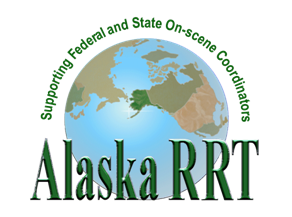Applicable Memorandums of Understanding/ Agreements (MOU/MOA)
The following documents represent existing agreements between response agencies at the federal and state levels.
Memorandum of Understanding between the Alaska Departments of Health and Social Services, Military and Veterans Affairs, Environmental Conservation, and Labor concerning emergency response to peacetime radiation incidents and accidents (September 1982). This MOU outlines specific agency roles and responsibilities during a peacetime radiological accident/incident. *Partially rescinded.
Letter of Agreement Between the Minerals Management Service, Alaska Outer Continental Shelf Region, and the Alaska Department of Environmental Conservation Regarding Pollution Prevention and Response Preparedness for Oil and Gas Facilities on Alaska Submerged Lands (October 2005). This Letter of Agreement was entered into by the parties concerned for the purpose of coordinating and implementing requirements with respect to oil spill prevention and response preparedness for offshore oil and gas facilities and pipelines on State of Alaska submerged lands and offshore areas which demonstrate a likelihood of affecting State waters in the event of a catastrophic spill. *Currently under review (January 2022)
Memorandum of Agreement Between the Alaska Department of Transportation and Public Facilities and the Alaska Department of Environmental Conservation (October 1998). This memorandum of agreement outlines the process for accessing and using Alaska Marine Highway System vessels (State ferries) in support of oil spill cleanup activities and operations. *Currently under review (January 2022)
Use Agreement Between the Alaska Department of Fish and Game and the Alaska Department of Environmental Conservation (October 1998). This use agreement outlines the process for accessing and using ADF&G vessels in support of oil spill cleanup activities and operations. *Currently under review (January 2022)
Memorandum of Understanding between the U.S. Environmental Protection Agency, Region 10, Superfund and Emergency Management Division and the U.S. Coast Guard Seventeenth District Concerning FOSC Response Boundaries for Oil Discharges and Hazardous Substance Pollutant and/or Contaminant Release, (January 2022). This MOU establishes the emergency response boundaries for Coast Guard and EPA FOSCs for response to oil discharges and hazardous substance releases in Alaska.
Memorandum of Understanding Between the United States Environmental Protection Agency and the United States Department of the Interior, Bureau of Land Management (May 1994). This MOU clarifies roles and responsibilities regarding preparedness and response to an Inland Zone Oil Discharge from the Trans-Alaska Pipeline System.
Memorandum of Understanding Between the Regional Director of the Minerals Management Service Alaska OCS Region and the Assistant Regional Administrator of the U.S. Environmental Protection Agency, Region 10, Alaska Operations Office (July 1994). This MOU establishes MMS responsibility for offshore oil facilities located in Cook Inlet, Alaska, as authorized in the MOU between the Secretary of the Interior, Secretary of Transportation, and the Administrator of the EPS, dated February 3, 1994, regarding division of Agency jurisdictional responsibilities for spill prevention and control, response planning, and equipment inspection activities under the Oil Pollution Act of 1990 (OPA 90).
Memorandum of Understanding on Oil and Hazardous Substance Pollution Prevention and Response Between the U.S. Environmental Protection Agency (Region 10) and the State of Alaska Department of Environmental Conservation (July 1997). This MOU outlines procedures for coordination and cooperation between the State of Alaska and the EPA (Region 10) with regard to implementing and exercising their statutory and regulatory duties related to oil spill planning, prevention, and response. *Currently under review (January 2022)
Memorandum of Agreement on Oil and Hazardous Substance Pollution Prevention and Response Between the Commander, Seventeenth Coast Guard District and the State of Alaska (June 2009). This MOA outlines procedures for coordination and cooperation between the State of Alaska and the USCG Seventeenth District in regard to implementing and exercising their statutory and regulatory duties related to oil spill planning, prevention, and response.
Inter-Agency Memorandum of Agreement Regarding Oil Spill Planning and Response Activities Under the Federal Water Pollution Control Act’s National Oil and Hazardous Substances Pollution Contingency Plan and the Endangered Species Act (2001). This agreement, which was approved by the USCG, EPA, DOI (OEPC and USFWS), and NOAA (NMFS and National Ocean Service), is used to identify and incorporate plans and procedures to protect listed species and designated critical habitat during spill planning and response activities.
Memorandum of Understanding Among the Secretary of the Interior, Secretary of Transportation, and Administrator of the Environmental Protection Agency (February 1994). This MOU establishes the jurisdictional responsibilities for offshore facilities (including pipelines) and outlines the basic responsibilities of the parties concerned with regard to spill prevention and control, response planning, and equipment inspection activities.
Oil Spill Memorandum of Cooperation between the Province of British Columbia, the State of Washington, the State of Oregon, and the State of Alaska, the State of California, and the State of Hawaii (2001). This memorandum outlines a cooperative effort amongst the signatory agencies to reduce the potential for major oil spills through development of a joint emergency response plan, technology sharing, joint exercises and training, and committee reviews of prevention and response procedures.
Pacific States/British Columbia Oil Spill Task Force Mutual Aid Agreement. The purpose of this agreement is to set specified conditions whereby certain contingency plan holders may be allowed to meet temporarily reduced response standards in order that their response equipment may be available for mutual aid. This agreement assures that most of the spill response equipment on the West Coast will be available to respond rapidly in the event of a major spill.
USCG and Bureau of Safety and Environmental Enforcement (BSEE) Index of MOUs/MOAs, Effective 2017.
Memorandum of Agreement Establishing an Operating Agreement for the Joint Pipeline Office (2008). The agreement calls for the signatory agencies to provide coordinated state and federal permitting, monitoring, enforcement, and preparedness planning activities on the TAPS and other petroleum and natural gas pipelines. The MOA encourages an intergovernmental relationship that will coordinate interagency action in regulating and overseeing pipelines pursuant to each agency’s authorities and regulations. *2022 Draft under review


